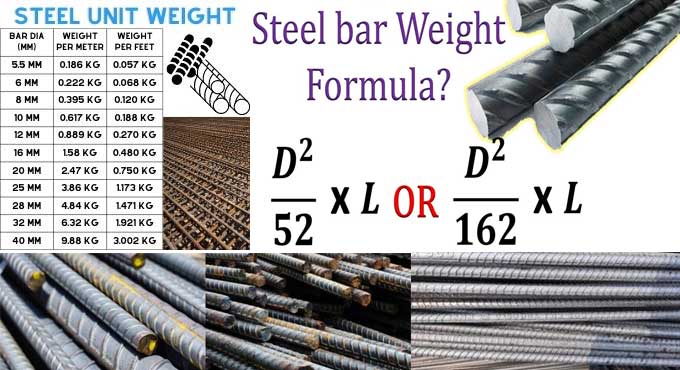NEWS | SOFTWARE | SHEET
Steel bar Unit Weight: Importance in Construction and Engineering
The unit weight of steel bar is an important factor to consider when working with steel bars in construction and engineering projects. Steel bars are used in a variety of applications, from reinforcing concrete structures to building bridges and buildings.
The unit weight of steel bar is a measure of how much a single meter of the bar weighs. Understanding the unit weight of steel bar can help you make informed decisions when planning and executing construction projects.
Steel Bars Types
There are a variety of different types of steel bars, each with its own unique properties and characteristics.
Mild Steel bar
The most common type of steel bar is the mild steel bar. These bars are made from low carbon steel and are suitable for a wide range of applications. They are commonly used in the construction of buildings, bridges, and other structures.
Mild steel bars are also used in the reinforcement of concrete structures, as they are strong and durable enough to withstand the forces exerted on the concrete.
High Strength Steel Bar
Another type of steel bar is the high strength steel bar. These bars are made from high-carbon steel and are designed to be stronger and more durable than mild steel bars. They are commonly used in the construction of bridges, buildings, and other structures that require extra strength and support. High strength steel bars are also used in the reinforcement of concrete structures, as they are able to withstand more force than mild steel bars.
Unit Weight Steel Bar Calculation
The unit weight of steel bar is typically measured in kilograms per meter (kg/m). The weight of a steel bar can be calculated using a simple formula:
Weight (kg/m) = D^2 /162.2, where D is the diameter of the bar in millimeters.
For example, the weight of a 16mm steel bar per meter is approximately 1.58 kg/m. Similarly, the weight of a 20mm steel bar per meter is approximately 2.47 kg/m.
It is important to note that these weights are approximate and can vary depending on the manufacturer and the specific grade of the steel bar. It's always best to check with your supplier for the exact weight of the steel bars you are using.
Benefits of Unit of Steel Bar
When selecting steel bars for a construction project, it is important to consider the unit weight of the steel bar in addition to other factors such as strength, corrosion resistance, and cost. The unit weight of steel bar can affect the overall weight and cost of the project, so it's important to choose steel bars that are the right weight for the job.
For example, in a high rise building construction, where weight is a crucial factor, choosing lightweight steel bars with high strength can be an ideal solution. On the other hand, in a bridge construction, where weight is not a significant factor, choosing steel bars with a high strength to weight ratio can be an optimal choice.
In addition to the unit weight, the grade of steel bar also plays a vital role in determining its strength. The grade of steel bar is determined by the amount of carbon and other alloying elements in the steel. Higher grades of steel bars have more carbon and other alloying elements, making them stronger and more durable.
To get more details, go through the following video tutorial.
Lecturer: civilogy
In conclusion, the unit weight of steel bar is an important factor to consider when working with steel bars in construction and engineering projects. Understanding the unit weight of steel bar can help you make informed decisions when planning and executing construction projects. The grade of steel bar also plays a vital role in determining its strength.
When selecting steel bars for a construction project, it is important to consider the grade of the steel bar in addition to the unit weight. Choosing steel bars with the right grade for the job can ensure that the finished structure is strong and durable enough to withstand the forces it will be subjected to.


